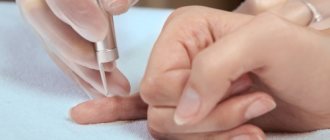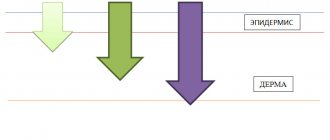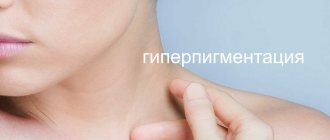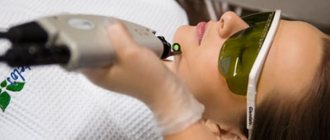Hypertrichosis is often confused with hirsutism. The difference is that with hirsutism, a woman’s hair grows according to the male pattern and the reason for this is the excessive formation of androgens. And with hypertrichosis there is too much vellus hair, which is distributed throughout the body and becomes black and hard.
The most pronounced hair in hypertrichosis appears on the body in the following places: the chin, above the upper lip in the area of the nasolabial folds, in the chest area, on the lower back, pubic hair begins to grow as in men.
Sometimes hypertrichosis develops in a girl during adolescence; less often, this disease can be found in a child.
Assessing the degree of female hairiness
Not all hair on the body is superfluous and, perhaps, you consider that vegetation that is physiologically acceptable and grows within normal limits to be superfluous. The Ferriman-Gallwey scale is used for assessment. The scale has 4 rating options (you can find comparative photos on the Internet): 0 - hair is completely absent, 4 - hair growth is well expressed. This scale evaluates vegetation in the following locations: above the upper lip, in the abdomen, back, chest, pubic area, arms and inner thighs. If you evaluate the degree of hair growth in all these places and score 8 points, then you can assume the presence of pathology.
How to remove hair from chin
In addition to tweezers and razors, the use of which leads to thickening, increased pigmentation of hair, skin irritation, and ingrown hairs, other methods are also used at home. Although, what to do when hair appears on the chin, a woman has the right to decide for herself.
Regular scissors. Acceptable method of removal. They will not help to a significant extent if the hairs are dark, since it will not be possible to remove hair on the chin absolutely at the root, but if the hair is light and differs from normal only in length, depilation of the chin using nail scissors will solve the problem. In addition, this method is preferable because the skin is not injured and the hairs do not become darker.
Removal by thread. They use thread twisted in a special way. A thread about 50 cm long is connected into a ring and twisted. The index fingers and thumbs of the left and right hands are threaded through the loops. The twist section should slide from one edge to the other as the fingers of one or the other hand move apart. The hairs will curl around the thread and pull out. The method has disadvantages:
- Not every woman will be able to use it, since this requires certain skill.
- Using a thread, you can remove the vellus cover. Thick black hair on the chin is difficult to remove with a thread. Firstly, the tool pulls out several hairs at once, and if they are thick, the procedure will be very painful, and secondly, it does not capture such vegetation well.
- The results don't last long enough.
As an alternative, a special spring is used. Working with it does not require any skills.
Important! The skin should be disinfected before epilation.
Depilatory cream. The cream contains substances that destroy keratin. This cream acts quickly, after which the hair is removed with a spatula. Advantages:
- the cream contains caring components and substances that slow down hair growth;
- prickly bristles usually do not form after their use.
However, depilatory cream is not suitable for every woman, because the chemical components can cause irritation, including the formation of abscesses and burns. In addition, the method is effective only on relatively fine hair. If the vegetation is tough, then the cream will not cope with it.
Removal with epilator. This is a possible but painful method. When using an epilator, it is recommended to cool the skin with ice to reduce pain. You will have to be patient, but the results last up to 3 weeks.
Important! After hair removal, it is useful to lubricate the skin with panthenol cream. Peeling is recommended on days 2-3 to avoid ingrown hairs.
Hardware hair removal
Hardware hair removal on the chin allows you to get rid of hair permanently or for a long time. Moreover, ingrown hairs cease to be a problem. In order for the effect to be lasting, all follicles are destroyed, including dormant ones, you will have to take several courses. The cost of the procedures is not affordable for everyone.
Laser hair removal. The laser affects the pigment, so the procedure will be most effective if the hairs are dark. It is not suitable for light vegetation. Hair follicles are destroyed, and hair that is in the growth phase dies. The procedure does not affect follicles that are in the sleep phase, so you will have to repeat the procedure several times to get rid of hair completely. About 10 procedures are required.
There are several types of hair removal devices:
- alexandrite – it is characterized by high processing speed;
- ruby – eliminates vegetation for a long time, practically does not damage surrounding tissues and does not cause pain;
- diode – hair growth on the chin is reduced, and the device is effective against dark and thick hair.
Photoepilation. The essence of the method is the same, only the impact on vegetation is carried out not with a laser, but with high-pulse light. During the procedure, there is a slight tingling sensation. After a course of procedures, not only hair disappears, but also the structure of the skin improves. The procedures must be completed within a year.
Elos. Suitable for removing both light and dark hair, because the effect occurs with a light pulse and electricity at the same time.
A cosmetologist talks about the method: Electrolysis. Proven and effective removal method. A very thin needle is inserted into the follicle, through which an alternating current discharge is delivered. As a result, the root dies. Dead hair is pulled out with tweezers. The disadvantage is that the procedure takes a significant amount of time, so it cannot be completed in one session. But growth stops almost completely. Sometimes scars remain on the skin after the procedure.
Electrolysis. Instead of alternating current, galvanic current is used. As a result, the exposure time increases, but the pain decreases. The essence of the procedure remains the same.
No method gives a 100% result, although hardware methods help get rid of hair for several years.
Use of folk remedies
There are proven folk recipes that will help remove hair on the chin at home.
- Datura decoction. It is necessary to take 3-4 plants along with rhizomes and prepare a decoction of 1 liter of water. The liquid should be boiled for an hour. Then the broth is filtered and the desired areas of the skin are treated with the cooled liquid after depilation. This needs to be done twice a day. The product slows down hair growth.
- Walnut juice, prepared from the peel of green fruits, is applied in the form of a compress to the chin (soak a piece of gauze). Keep the compress for no more than 5 minutes. With systematic use of the product, growth stops. Walnut juice can stain the skin.
- Squeeze the juice out of half a lemon and mix it with 1 tbsp. Sahara. Evaporate the liquid to half the volume and distribute the cooled mixture over areas with vegetation. After 5-10 minutes, the composition is washed off with water.
- When using hydrogen peroxide, hairs cannot be removed, but they can be lightened. To do this, wipe areas with unwanted vegetation daily with 3% hydrogen peroxide, soaking a cotton swab in the liquid.
- The following recipe will help you get rid of hair on your chin: combine 3 parts of ethyl alcohol and 1 part each of ammonia and castor oil. A few drops of iodine are added to the mixture. The product is aggressive, so you need to handle the skin with caution, it can cause burns.
- The skins of green walnuts are turned into ash. To do this, the peel is removed and dried, and then burned. Ash prepared from the peel of one nut is mixed with 1 tsp. water and wipe the skin with the solution. After treatment, dark spots may remain on the skin that cannot be washed off for several days.
- If the hairs are dark but thin, you should wipe them several times a day with lemon juice or hydrogen peroxide. This will lead not only to lightening of the hair, but also to the destruction of its structure from the inside. It will become brittle. You can also use masks that help lighten vegetation with walnut, grape, or kefir juice.
- They combine several active ingredients at once, for example, they use lemon juice and hydrogen peroxide in a complex. Take one part each of lemon juice, flour, hydrogen peroxide solution (2 tablets per 1 tablespoon) and 4 parts of beaten egg whites. The mask is applied to areas with unwanted hair and then washed off with water after about 10 minutes. You need to carry out the procedure every day, then the hairs will not only become discolored, but also break off.
A few more original ways to get rid of hair at home:
Hair removal in a beauty salon
The beauty salon will offer to remove hairs on the chin using waxing and sugaring.
Waxing. Both cold and hot wax are used. Cold application involves the use of wax strips. Hot wax is applied with a spatula to the entire surface of the chin at once. This method is painful, but fast. Hairs do not appear for quite a long time, the first ones begin to emerge only after a week, and they grow unevenly and become thinner and lighter over time. They break through completely only after a month.
At first, removing unwanted hair on the chin using this method is painful, but with periodic use of wax, the skin adapts and the painful sensations dull.
Among the disadvantages it should be noted:
- the likelihood of ingrown hairs;
- possibility of burns;
- the need to grow vegetation to at least 3-4 mm. Otherwise, the wax does not capture the hairs.
Sugaring. In terms of the type of procedure, the process of removing vegetation with sugar paste is very similar to waxing, but there are several important differences:
- sugar paste is completely natural;
- Hair removal is not done against hair growth, as with waxing, but in the direction of growth;
- Sugaring does not have to be done in a salon; you can even make sugar paste yourself. To do this, you just need to know the required proportions of water, sugar and lemon juice;
- the method is less painful.
Important! Hair becomes thinner and less noticeable over time.
Sugaring is contraindicated in case of individual intolerance to the components included in the paste (honey, lemon juice, sugar).
You can see how specialists in beauty salons do this in the video:
If the removal technique is incorrect, the hair grows in, bruises and burns form.
Symptoms
It is clear that the main symptom of hypertrichosis in women is excess hair growth on the body, mainly of the male type: in the bikini area, the growth of a mustache and sideburns, hair around the nipples, on the back of the thigh, etc. However, there are some other symptoms that should alert you:
- acne, acne;
- increased oily skin, seborrhea;
- lack of ovulation;
- menstrual irregularities, which is expressed in delayed menstruation or absence;
- increased hair loss on the head and, especially, in the crown area;
- overweight, obesity
Procedures for hirsutism in women
- Shaving, bleaching, waxing. Many cosmetologists and doctors believe that in case of hirsutism, these procedures are strictly prohibited, since women's skin is very delicate, and such manipulations cause irritation, redness and inflammation, and this, in turn, provokes the appearance of even more hairs, as well as their ingrowth.
- Depilatory creams are an acceptable method as they do not cause the above symptoms.
- Laser hair removal and photoepilation are considered the most effective and harmless method, since they stop hair growth and do not cause inflammation or ingrown hairs.
The prognosis for hirsutism is not the most favorable; it is not possible to completely get rid of the disease. However, the patient can stop hair growth, thereby significantly improving her quality of life!
Related articles: Laser hair removal - contraindications
Hairiness - causes
Excessive hair growth can be caused by various pathologies and genetic characteristics. Let's look at these reasons in more detail:
- ovarian dysfunction - this condition can be caused by polycystic disease, benign and malignant tumors, lack of ovulation against the background of dysfunction of other organs;
- pathologies of the hypothalamus and pituitary gland, organs that regulate the production of many sex hormones;
- problems with the adrenal glands - can also be caused by neoplasms, acquired or congenital hyperplasia of the adrenal cortex, etc.;
- heredity - there are a number of chromosomal features that cause excessive production of male sex hormones, which causes an increase in female hairiness (a striking example of such features are Caucasian women and some other nationalities);
- long-term use of hormone-containing drugs (androgens, corticosteroids, etc.);
- idiopathic syndrome is an independent disease that causes discomfort, but all studies show the norm;
- age-related changes in hormonal levels - for example, in menopausal women, the hormonal levels change, which can cause increased hairiness;
- changes in hormonal levels during pregnancy or puberty - this is rare, but it does happen; after the birth of a child or exit from puberty, everything usually falls into place.
Hair removal by shaving
Shaving is one of the fastest and easiest ways to remove hair. Whether you use a disposable razor or an electric razor, both have a built-in blade that removes hair from the surface of the skin. However, the results are not permanent or long lasting. Your face will remain hairless for one to three days, and then you will have to shave again.
For best results, cleanse your face and apply a layer of shaving cream. This promotes a smooth surface and reduces the chance of cuts.
Keep in mind that while this method is relatively safe, ingrown hairs can be a side effect of shaving.
Consequences
Increased hairiness in our time causes serious emotional discomfort to women and forces them to undergo many cosmetic procedures. If you don’t notice the problem for a long time and don’t look for a solution, you can seriously neglect your health, which will lead to the following consequences:
- baldness;
- development of female infertility of various nature;
- endometrial hyperplasia;
- insulin resistance;
- diabetes;
- hyperlipoproteinemia.
Hair removal by epilation
Epilation is another option for removing facial hair. This technique can eliminate hair for up to four weeks, which may be a better choice if you're busy and don't want to shave or pluck regularly.
Epilators grab a few hairs and remove them from the root. Since the hair is removed from the root, it takes longer to grow back. Sometimes hair removal results in hair becoming softer and thinner.
You don't need to prepare your skin when using an epilator. However, exfoliating a couple of days before helps soften the skin and reduce the risk of ingrown hairs.
The process may be painful; apply an ice cube to the painful areas to reduce swelling and inflammation.
Diagnosis of increased hairiness in a girl
If you have a problem and want to fix it, the first step is to contact a specialist. The following specialists deal with this problem: endocrinologist, gynecologist, dermatologist. A specialist will study your problem and, if necessary, tell you what tests to take and what procedures to carry out.
The doctor examines the patient’s medical history and is also interested in the following questions:
- what medications the patient takes, for how long, for what purpose;
- whether there is a menstrual irregularity;
- whether there are relatives with similar symptoms.
The doctor also prescribes the necessary laboratory blood tests: for certain hormones, as well as biochemical and general blood tests.
If necessary, the following studies are carried out to clarify the picture:
- Ultrasound of the pelvic organs;
- It is possible to conduct an MRI or CT scan of the adrenal glands, pituitary gland, hypothalamus.
Hair removal with wax
There are two types of wax kits: wax strips that you warm between your hands before applying, and wax that is melted in heaters and then applied to the desired area with special sticks.
When you buy wax, look for a soft wax or a wax that is designed for use on the face.
If you choose wax that needs to be warmed at home, purchase a wax warmer. The wax warmer heats the wax evenly and allows for better temperature control. Also, make sure to buy a lot of wax sticks so that you only use each stick once. Double use may introduce bacteria into the wax and cause a skin infection.
Before waxing, apply a wax patch to your skin to check if you are developing an allergic reaction and make sure the wax is at the right temperature. The wax should not be too hot. It should glide on your skin easily.
Waxing can cause blackheads and ingrown hairs. Waxing should be avoided if you are using retinoids.
How to treat excessive hairiness in a girl
There are several treatments for hypertrichosis in women. Let's look at medical treatments and methods that help hide hairiness in girls.
Treatment
The key to effective treatment is sufficient diagnosis, as a result of which the cause of the development of the disease was determined. Depending on what caused it and the individual characteristics of the person, treatment is prescribed:
- hormone therapy (oral contraceptives);
- Often, losing excess weight helps bring hormones back to normal without taking additional medications;
- the use of drugs that block androgens (male sex hormones).
It is worth remembering that bringing hormonal levels back to normal takes several months or more; this is a long process that requires constant compliance with the doctor’s instructions.
If hypertrichosis is caused by neoplasms or physiological characteristics of certain organs, then surgical intervention may be prescribed.
What not to do if you have hair on your chin
Hair growing on the chin brings psychological discomfort, so women are looking for optimal ways to remove it. When choosing the optimal method, you should remember that the skin in this area is delicate, and removing hair from the chin in women using aggressive techniques can lead to irritation.
Note! It is not advisable to use aggressive folk remedies, such as scrubs, ammonia, or datura tincture, if your skin is sensitive.
The most common method for removing unwanted vegetation is pulling it out with tweezers. However, it is convenient to use if the scope of work is small. If a full-fledged beard grows on the chin, pulling it out with tweezers is long and painful. In addition, the hair must be long and thick enough, otherwise it will break off.
Important! When systematically removing hair with tweezers, it thickens and becomes darker. And in place of one removed hair, several grow.
A razor is also not the best option. It can be used in a hurry, but the problem is that it only removes the visible part of the hair shaft, which means that already on the 2-3rd day, short, prickly hairs will appear above the surface of the skin. Maybe they are still invisible from afar, but this does not add comfort. Eventually, a woman will grow coarse black hair on her chin, reminiscent of male stubble. In this case, chin hair removal is preferable rather than depilation.
Using Vaniqa cream
Even if you shave, wax, tweezer, or thread, unwanted facial hair will grow back over time. Although there is no prescription hair removal cream, Vaniqa is the only drug approved for reducing the growth of unwanted facial hair in women. Talk to your doctor to find out if this drug is right for you.
This medicine does not work overnight, so you will have to use other hair removal methods. When applied to the face twice daily (at least eight hours apart), you may notice less hair within four to eight weeks.
Keep in mind that this medication is not intended to be used alone and will not permanently remove hair. If you stop applying the cream, your facial hair will grow back.
Sources: • https://www.healthline.com/health/how-to-remove-facial-hair • https://www.littlethings.com/what-causes-chin-hair
Hair removal with epilation cream
Depilatory creams are another option for removing facial hair. Results may last longer than shaving, and these creams may be less expensive than waxing.
These creams contain chemicals such as sodium, titanium dioxide and barium sulfide, which break down the proteins in the hair so that they dissolve and rinse off easily. While these ingredients are generally safe, there is an allergy risk.
If this is your first time using depilatory cream, first apply a patch with a small amount of cream to your skin. Signs of an allergy include skin redness and itching. Wait at least 24 hours after patching before applying the cream to large areas of your face.
These products are available in gel, cream and lotion form. While these creams can remove hair from any part of the body, some creams are formulated specifically for facial hair. They also smooth, exfoliate and hydrate the face.










